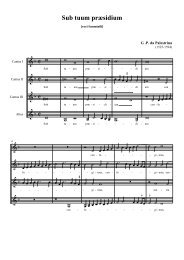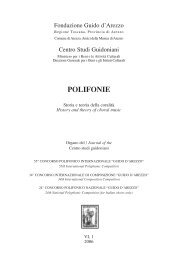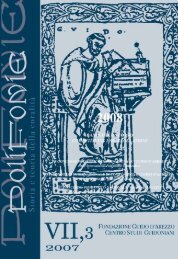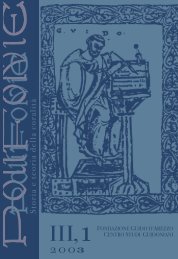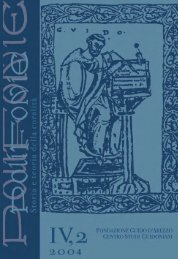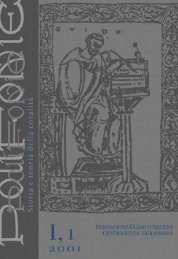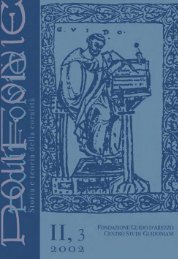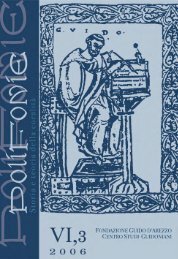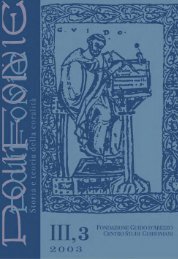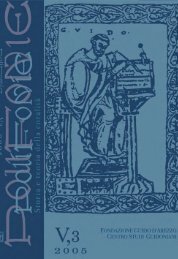Riviste Polifonie/119_2005 n 2.pdf - Fondazione Guido d'Arezzo
Riviste Polifonie/119_2005 n 2.pdf - Fondazione Guido d'Arezzo
Riviste Polifonie/119_2005 n 2.pdf - Fondazione Guido d'Arezzo
Create successful ePaper yourself
Turn your PDF publications into a flip-book with our unique Google optimized e-Paper software.
RODOBALDO TIBALDI<br />
Beati omnes qui timent Dominum, 10 v. L. Torchi, L'arte musicale in Italia,<br />
vol. II (1897)<br />
Sacrae cantiones, 1597<br />
O Iesu Christe miserere mei, 5 v.<br />
F. Commer, Musica Sacra, vol. XXVII<br />
(1886)<br />
Since 1967, however, very little can be added. Rüegge himself transcribes<br />
in an appendix to his book the motets Speciosa facta es (1597, 5 v.) and Osculetur<br />
me (1590, 6 v.), while O sacrum convivium (1590, 5 v.), along with a new<br />
transcription of Quem vidistis, pastores?, can be found in a doctoral dissertation<br />
by Michèle Fromson together with other polyphonic settings of the same<br />
texts. 6 It seemed useful, therefore, to offer modern editions of certain other<br />
works using different forces, including double choir, so as to give a more<br />
instructive preliminary picture of Vecchi’s motet output.<br />
To conclude, a brief note on the edition of his music. Both the wide range<br />
of note values used by Vecchi for the notes of syllabic value (running from the<br />
breve down to the semiminim) and the actual tactus (wavering between the<br />
semibreve and the minim) have made the maintenance of the original values<br />
practically inevitable. Also maintained, for similar reasons, are the mensuration<br />
signs, which are c and ¢ in the motets of the first collection, and exclusively<br />
¢ in those of the second. Their preservation also has a documentary<br />
value, testifying to a compositional practice at times influenced by rhythmic<br />
structures specific to secular music, and at times seeming to differentiate the<br />
two mensurations semantically (and semiologically) depending on the liturgical<br />
occasion (even though the process is not always linear and consistent,<br />
above all as far as the notation is concerned). Finally, above all in the sacrae<br />
cantiones of 1597, it seems to imply a theory of genres and related compositional<br />
techniques, regardless of the actual tactus required and/or the notation,<br />
and to move decidedly in the direction of offering a purely external and graphic<br />
display of the concept of gravity, which begins to assert itself, at various<br />
levels and with various meanings, in the very concept of sacred music in the<br />
stile osservato. 7 So much for the sections in duple metre. As for the triple-time<br />
sections, which are invariably measured in breves and semibreves, the traditional<br />
tactus theory would appear to be more applicable. In fact, however, this<br />
is also another instance of the crisis of a notational system that still lacked sufficient<br />
means of writing in a manner different from, and more consistent with,<br />
6<br />
MICHÈLE YVONNE FROMSON, Imitation and Innovation in the North-Italian Motet, 1560-1605, 2<br />
voll., PhD. diss., The University of Pennsylvania, 1988, vol. II, pp. 127-131 (Quem vidistis, pastores?)<br />
and 192-206 (O sacrum convivium).<br />
7<br />
I shall expand on these points in greater detail in my forthcoming article.<br />
122



